Tori Nabe: Japanese Chicken and Vegetable Tabletop Hot Pot

Nabe (鍋, pronounced NA-beh) is the Japanese word for a pot or pan. But it also means a one-pot dish where several ingredients are cooked together in a broth. While nabe can be cooked in the regular way on the stovetop, the most popular kind of nabe are cooked at the table on a portable burner. The quintessential image of a Japanese happy family is one that gathered around the dining table eating a nabe. (Nabe cooked at the table is also called yosenabe (寄せ鍋), which just means a nabe where the ingredients are gathered together (寄せる、yoseru). Because a nabe is piping hot, it's a great winter meal, with very little preparation.
A lot of Japanese nabe recipes call for ingredients that are only widely available in Japan, but this is a recipe for a nabe that you can recreate wherever you are. It uses chicken and a lot of vegetables, so it's very healthy and frugal - perfect recession cooking! The only special equipment you need is a tabletop cooker of come kind, that can sustain a boiling heat. See more about tabletop cookers in the Notes at bottom.
Recipe: Torinabe (鶏鍋), Japanese Chicken and Vegetable Tabletop Hot Pot
To serve 4 hungry adults
- 1 large piece of dried konbu seaweed, or about 1 Tbs. of dashi stock granules or 1-2 regular chicken stock cubes
- 400g / about 12 oz. boneless chicken, dark or white meat (I used dark meat) cut into cubes
- 1 block of firm tofu or yakidofu (firm tofu that has been lightly grilled on the outside, available at Japanese grocery stores), cut into chunks (allow for 2 chunks per person)
- 1 small or 1/2 large chinese/napa cabbage, cut up into chunks
- a bunch of green leafy vegetables - I used spinach
- 1 pack of enoki or staw mushrooms, separated into small bunches
- 4 large raw shiitake mushrooms, stems cut off (you can use portobello mushrooms instead, sliced - one big one should do it)
- The white of 1 leek, sliced
- 1 pack of fresh or frozen udon noodles, or 2-3 cups of cooked rice, or 1 pack of rinsed and blanched hirataki noodles, or any combination of the three
Condiments:
- Soy sauce
- Ponzu or yuzu or lemon
Equipment:
- Tabletop cooker (see Notes below)
- A stable, heavy bottomed pot, ideally one that's attractive enough for the table (I used a medium size powder blue Le Creuset pot)
- Long chopsticks or a long fork or tongs
- Ladle
- Smallish bowls for serving, one per person. Breakfast cereal sized bowls are good.
Put the piece of konbu seaweed in the pot and fill up halfway with water. (Ideally you want to soak the konbu for a while, so if you can plan ahead put the water and konbu in the pot in the morning or something.) Bring up to a boil. If you can't get hold of konbu, dashi granules like Hondashi are ok. Or you could even use regular stock cubes or stock powder, though of course it won't taste as nice. You could even use canned chicken or vegetable stock. Here I've used a generous piece of konbu. You can take the konbu out, or just leave it in as you cook the hotpot.
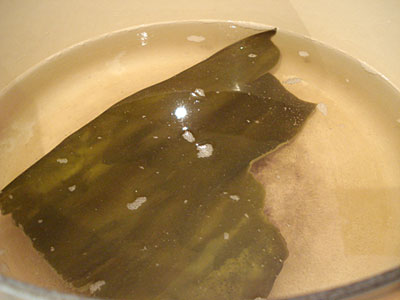
Make your ingredients ready in the meantime. Here you see the cut up Chinese cabbage, spinach and enoki mushrooms. (The traditional nabe green vegetable is shungiku (edible chrysanthemum leaves), but that's not that easy to get outside of Japan, or if you can get it it can be expensive - though look for them at you Asian grocery store. Any green will do though - here I've used plain old spinach, but pak choi /bok choy is good, as is Chinese broccoli, Swiss chard, and so on. Use what's available to you. And the mushrooms can be switched around too - if you can't get enoki or shiitake, use something else, though white button mushrooms are not that nice in this. Portobellos, chestnut mushrooms, shimeji, maitake - all are good. )
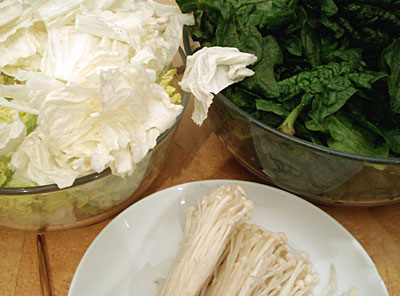
And here's the chicken. I did leave the skin on but you can take it off if you prefer. 3 ounces / 100g may not seem like much but people will be full! Not pictured: tofu, shiitake, and the sliced leek. (The photographer forgot them.)
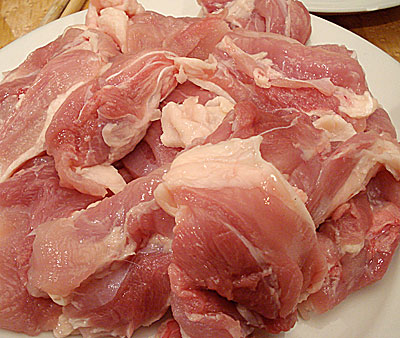
When the pot comes to a boil, lower the heat a bit and just start putting the ingredients in. Start by putting in some chicken pieces (reserve some for putting in later, after the first batch of chicken is eaten up), then add the vegetables. You may want to start with the leeks, then the other vegetables - but really, there are no hard and fast rules. All you need to do is to simmer until done. The tofu and the shiitake benefit from being in the pot longer, so they can soak up the flavors from the broth, which will get more and more flavorsome as the meal progresses. Note: skimming off any scum that rises to the surface will make the broth taste better, but again it's not a critical point.
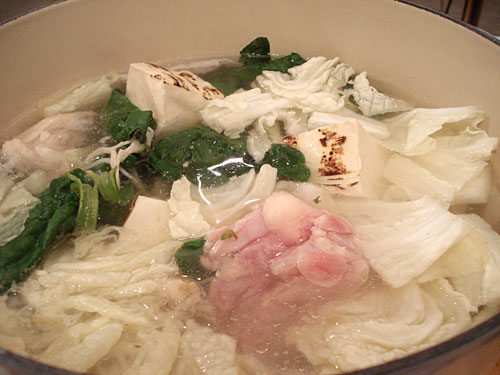
When things get cooked, take them out into the individual bowls with the chopsticks or tongs and the ladle. (In Japan they sell nice short wooden ladles for nabe. See if your local Japanese grocery store carries them.) Each person then adds the condiments to their taste. The traditional ones for tori nabe are ponzu and soy sauce. You can get ponzu at a Japanese grocery store or even at many regular grocery stores in the U.S. these days. If you can't get it, fresh lemon juice will do. (If you're in Japan, you can go one step better than ponzu and get a fresh sudachi (すだち, a greenskinned citrus fruit) and squeeze that on. Yuzu juice is nice too.)
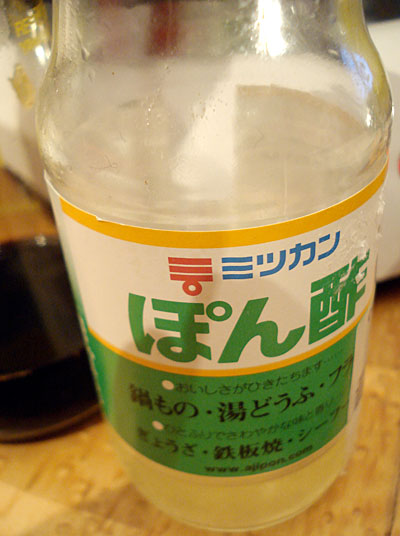
Here's a helping of the hot pot. Lots of vegetables, a little chicken, tofu, and some of that broth.
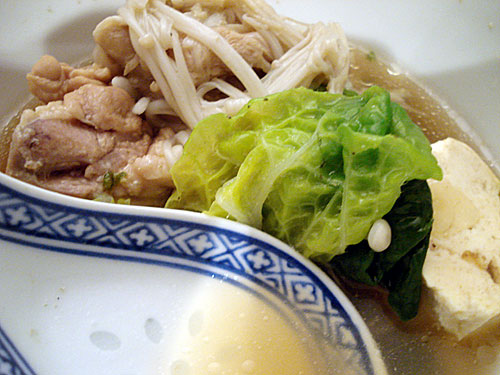
As the pot gets depleted, just keep adding things until you run out, or until everyone is almost full. Don't throw out the leftover broth though - that's the tastiest part of the meal! Usually you would cook some udon noodles in that flavor-packed broth, and serve that to end the meal. I didn't have any udon noodles on hand, so I just put in some rice. Other things you could put into that last broth: dumplings, shirataki noodles (for the low-carb or dieting crowd), etc. - anything that can slurp up that flavor.
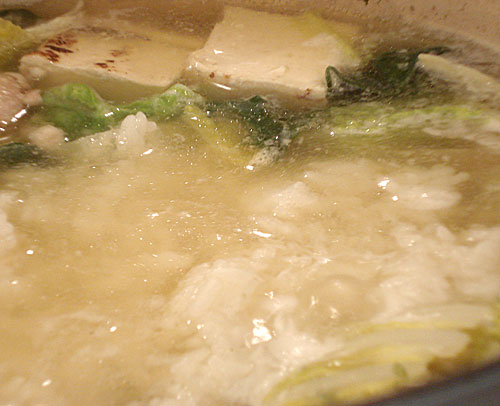
Nabe are great for parties, but they are really easy on the cook too since all you have to do is to cut things up and take out the burner and the pot.
Notes
Tabletop burners are not that expensive, and can be great fun. This type of one-ring gas burner is perfect. I use an electric burner since gas cooking is almost unheard of here. It's similar to this one. The burner has to be able to sustain a boiling heat in the pot.
Do be careful of little kids around a hot pot and burner on the table! Remember to use a heavy pot that can't easily be tipped over, and don't let little hands poke around in the pot unless they are experienced.
If you enjoyed this article, please consider becoming my patron via Patreon. ^_^

 Welcome to Just Hungry, where we serve authentic Japanese recipes and more! I'm
Welcome to Just Hungry, where we serve authentic Japanese recipes and more! I'm 













Comments
mika
11 January, 2009 - 23:48
Permalink
Re: Tori Nabe: Japanese Chicken and Vegetable Tabletop Hot ...
eeh~ i LOVE nabe. i remember asking my mother to add extra shiitake mushrooms. i was the odd one out in the family: i added kewpie to my bowl.. acquired taste?
Micki
12 January, 2009 - 03:44
Permalink
Re: Tori Nabe: Japanese Chicken and Vegetable Tabletop Hot ...
Nabe is in the zeitgeist! This winter has been a real nabe winter (I think last winter we made a lot of bibimba.) I made up a nice chicken stock, then add frozen seafood mix and mushrooms, and my mother-in-law's Chinese cabbage. And naganegi, if I remember to get it at the store. The naganegi makes it lovely!
We flavor it with menmi most of the time (yeah, it's a cheat, but an easy cheat), but sometimes I do it up with consomme powder to make a bouillabaisse; we eat it with french bread and butter. MMMMMMMM.
My MIL likes to put mochi-stuffed kinchaku (the wrappers that you use to make inari-zushi, with a wedge of pounded rice stuffed into the middle, then tied off with a strip of kanpyou aka dried gourd strip.)
Gosh, I'm so glad to find this site! I live in Japan, but the perennial problem of "what's for dinner" affects me here, too. I'm going to check back often!
Swati
12 January, 2009 - 12:58
Permalink
The butterfly award for the coolest blog..
Hi,
Am delurking just to let you know that you have been awarded The Butterfly Award for the coolest blog I know. Do claim it at http://hellonetbaby.blogspot.com/2009/01/rest-pause-recharge-and-little-... and pass it on to ten more :)
Regards,
Swati
P.S. My blog, 'Hello, net baby!' is about websites for young children; nothing to do with cooking!
maki
13 January, 2009 - 09:24
Permalink
Re: The butterfly award for the coolest blog..
Thank you very much for the award Swati :) I'm glad you like the site!
Kim
13 January, 2009 - 00:46
Permalink
Re: Tori Nabe: Japanese Chicken and Vegetable Tabletop Hot ...
Lovely post! I just bought a tabletop burner and made my first nabe on New Year's Day, and I'm absolutely in love with the experience of this type of meal. I was surprised at how easy it was to find the ingredients (in Birmingham, Alabama, no less!) and once the prep was done, the meal was really quite simple. I tried a shabu-shabu recipe with paper-thin beef. My favorite part was serving the broth atop udon noodles at the very end. I bought some chicken to try a recipe similar to this one later this week. Thanks for the inspiration!
Mare
11 October, 2012 - 22:07
Permalink
Re: Tori Nabe: Japanese Chicken and Vegetable Tabletop Hot ...
I'm in Gadsden, AL - any recommendations for shops in B'ham?
tofuchan
13 January, 2009 - 03:42
Permalink
Re: Tori Nabe: Japanese Chicken and Vegetable Tabletop Hot ...
oh i just found this site!! it's awesome..i love it! i love nabe! =)
i've been trying to learn to make more japanese food as my mom used to make it for me all the time when i was little but she doesn't live anywhere near me so i can't really learn from her anymore...thanks for this site!
Cliff
14 January, 2009 - 00:12
Permalink
Re: Tori Nabe: Japanese Chicken and Vegetable Tabletop Hot ...
I was wondering what the ingredients that are usually used that you left out since it really isn't easy to find what so ever outside of japan. Just curious.
maki
14 January, 2009 - 02:15
Permalink
ingredients
Well, I chose tori nabe specifically because most of the ingredients shouldn't be hard to get. The only thing I swapped out is the shungiku - any kind of dark green leafy vegetable could be used instead. There are other nabe that use things like various kinds of seafood, or regional vegetables, and so on. Some of these may be obtainable say in NYC or LA etc. for a price, but probably not in the Midwest or most of Europe, etc.
Cliff
14 January, 2009 - 09:00
Permalink
Re: ingredients
Ah I see :) Living in LA I probably could find some of the ingredients, but it is much easier if it is widely available or easily substituted like you said. Cool I know what to make for dinner tomorrow !!! ^_^
kin-chan
3 January, 2010 - 20:17
Permalink
Re: ingredients / Midwest
Although we don't have Mitsuwa like in Torrance, Chicago or NJ, we have plenty of Japanese grocery stores out in the Midwest. Since the 1980s, Japanese automotive companies have established themselves throughtout the Midwest and the food supply has followed. Here in Indianapolis, they've even converted a large K-Mart into an international superstore with new, different kinds of vegetables that I've never tried. Even regular supermarkets carry bokchoy, napa, shiitake and other Japanese/Asian food stuff.
The Midwest has come a long way. Even in the Northeast, I remember the days in early 1970s when finding Sapporo Ramen was a treat. In early 1990s, there was a grocery stockboy who didn't know what garlic was... I thought he was screwing with me but true story.
Although we don't have the Village or Venice, we do have quite a bit out here in the Midwest and helluva alot more affordable than NYC or LA.
yuko
14 January, 2009 - 19:22
Permalink
Re: Tori Nabe: Japanese Chicken and Vegetable Tabletop Hot ...
If you can get it, daikon oroshi (grated daikon) and yuzu kosho will make it taste even better
Rena Takahashi
16 January, 2009 - 01:50
Permalink
Re: Tori Nabe: Japanese Chicken and Vegetable Tabletop Hot ...
Ahhh nabe! That's comfort food for me. In California shingiku is readily available at Japanese grocery stores. If you can't find it, carrot greens are actually a good substitute! We used to use carrot tops when we lived in Ann Arbor, MI because we missed shingiku so much.
I never thought of putting udon in at the end. We always ate the nabe with a good bowl of rice, some ponzu sauce and a raw egg!
BarbJ
17 January, 2009 - 19:54
Permalink
Re: Tori Nabe: Japanese Chicken and Vegetable Tabletop Hot ...
I have a Faberware electric fry pan that is about 4 inches deep with straight sides. It has a thermostat that goes up to 450*F and is made to cook on a counter top. It has legs that keep it up off the surface.
Do you think I could use that to make Tori Nabe?
Just adults and teen here, no small children, so I think we would be OK with a cord over the edge of the table.
I'd love to try this, it looks like it would be fun for a small dinner party!
Susan
6 January, 2016 - 20:45
Permalink
This would work great.
This would work great.
dita
25 January, 2009 - 15:15
Permalink
table burners
Have you ever used a fondue equipment (i.e. the caquelon plus rechaud) as table burner? I know that it's able to sustain boiling heat... I might just as well try it.
Guruman
26 January, 2009 - 00:08
Permalink
Re: Tori Nabe: Japanese Chicken and Vegetable Tabletop Hot ...
The Fondue burners can maintain the temperature, but only to some extent; Nabe can be compared to Fondue Chinoise, and there, the temperature of the broth is maintained. Or with a Fondue Bourgignonne, the oil temperature can be maintained as well. This works with an accordingly small pot.
However, the big difference between Nabe and Fondue Chinoise is the size and amount of stuff put into the pot over the time, which cools the liquid way more.
It might be a bit borderline, but I have a tabletop heater for Flambés, which uses the same burners as the Fondue heater, and has space for 3 heaters. Such a set up might actually work for Nabe.
Pat
21 December, 2009 - 21:37
Permalink
Re: Tori Nabe: Japanese Chicken and Vegetable Tabletop Hot ...
This is a great dish now for winter. I made this a few times before and will have it tonight. The only variation I do is use pre-marinated teriyaki chicken (dark meat) I get from the Asian market. It makes the brother a notch more flavorful. Mmmm.
anon.
4 April, 2010 - 04:20
Permalink
Re: Tori Nabe: Japanese Chicken and Vegetable Tabletop Hot ...
This recipe looks good! However, It is not mentioned whether or not i take out the konbu. Or do i leave it in the pot?
anon.
1 April, 2010 - 17:30
Permalink
Re: Tori Nabe: Japanese Chicken and Vegetable Tabletop Hot ...
for this recipe, do I take out the konbu after the pot boils? Also, when do i start putting the chicken?
Jessica
6 December, 2010 - 10:17
Permalink
Re: Tori Nabe: Japanese Chicken and Vegetable Tabletop Hot ...
Just wanted to let you know that I linked to this post here; http://tokyokitchentales.wordpress.com/2010/12/06/seasonal-spotlight-nabe/ I don't make tori nabe very often so it was nice to run across this recipe which looks very good!
Ophelia
22 February, 2011 - 20:46
Permalink
Re: Tori Nabe: Japanese Chicken and Vegetable Tabletop Hot ...
This may seem like a dumb question, but how long do you cook the chicken for? I've never boiled chicken, and I'm sort of paranoid about poisoning someone :o/
anon.
29 January, 2012 - 18:41
Permalink
Re: Tori Nabe: Japanese Chicken and Vegetable Tabletop Hot ...
You mention using a crockpot as a substitute for the nabe and table top burners. Unfortunately, my nabe did not make it back from Japan in one piece and I haven't found any other reason to by a burner.
My aunt has a crockpot, but I'm a novice at how they work. How should I go about using it for the nabe soup base? Would putting it on high and letting it sit for 2 hours before adding the veggies work just as well as using the nabe? Or are there any tricks/tips you can suggest?
Thanks!
maiku
26 December, 2012 - 06:43
Permalink
Re: Tori Nabe: Japanese Chicken and Vegetable Tabletop Hot ...
The link to your gas burner at Amazon is bad. I think this is what you meant:
http://www.amazon.com/Max-Burton-Table-Burner-Black/dp/B000G6S8Y8/ref=no...
(Not sure if I got the referral part of the URL right. Please edit if needed.)
maki
26 December, 2012 - 15:20
Permalink
Re: Tori Nabe: Japanese Chicken and Vegetable Tabletop Hot ...
Actually a one-burner gas cooker would be better. I've put in a new link above (this was written some years ago so the originally iinked item is probably not available anymore.) Thanks for pointing it out!